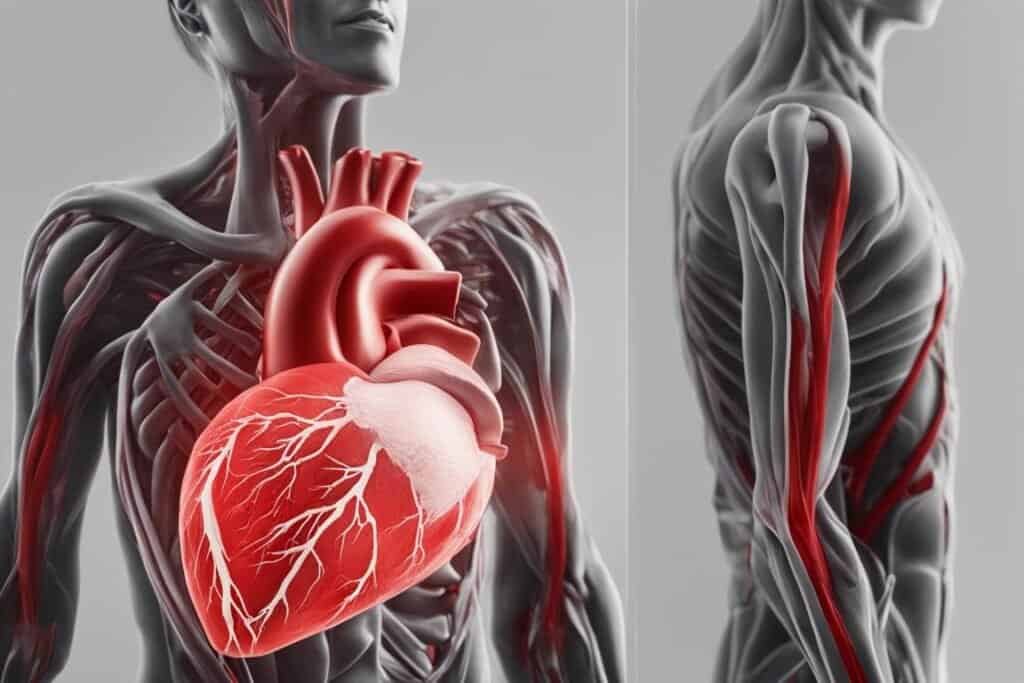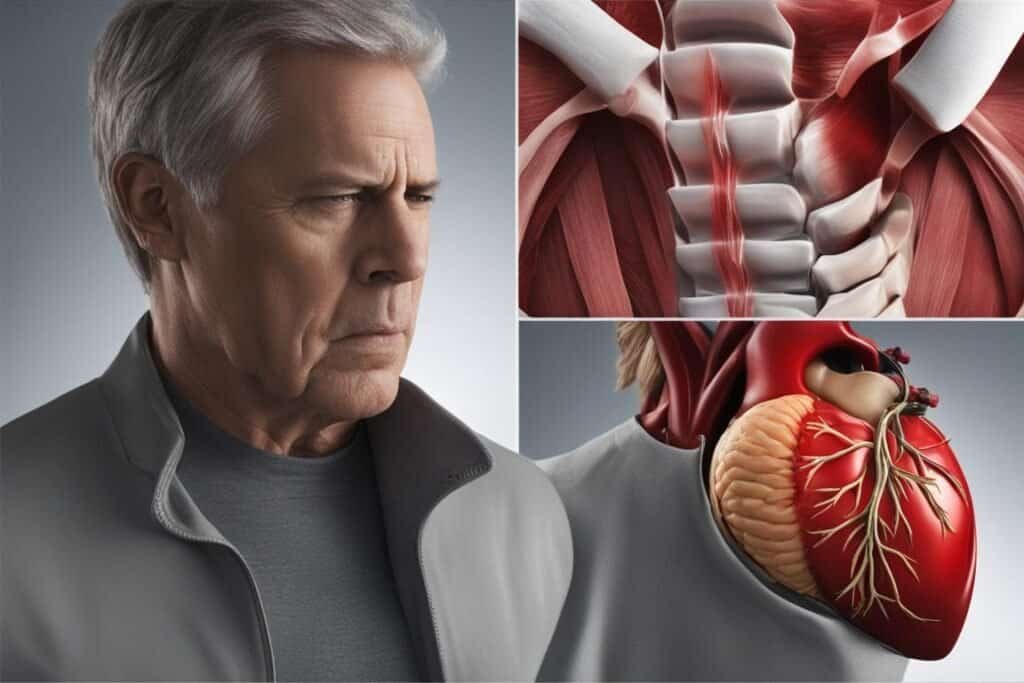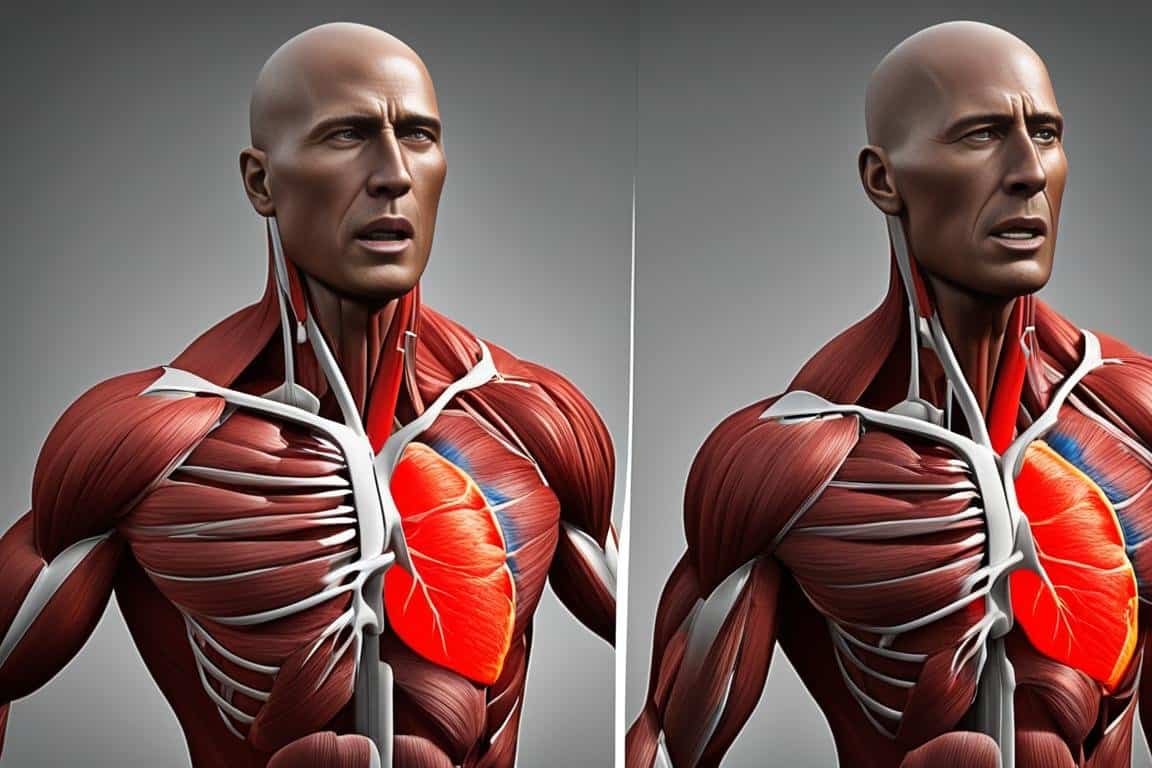When experiencing chest pain, it’s crucial to understand the key differences between a heart attack and a pulled muscle. While both can cause discomfort in the chest area, there are specific symptoms, causes, and treatments that distinguish the two conditions.
Heart attacks occur when there is a blockage in an artery, preventing oxygenated blood from reaching the heart muscles. Common symptoms include sharp pain and tightness in the chest, difficulty breathing, radiating pain down the left arm, nausea, sweating, and an irregular heart rate. Prompt medical attention is vital to minimize damage and improve outcomes.
Pulled muscles in the chest are typically less severe than heart attacks but can still be quite painful. They are often caused by overstretching or pressure on the muscles, commonly seen in athletes or those engaging in forceful or repetitive motions. Symptoms of a pulled muscle in the chest include chest pain that worsens with movement, tenderness, bruising, swelling, and muscle spasms. Rest, ice, compression, elevation, and over-the-counter pain relievers are usually sufficient for treatment. Stretching, warm-ups and proper lifting techniques can help prevent future muscle strains.
While chest pain is a common symptom in both heart attacks and pulled muscles, there are key differences to consider. Heart attack symptoms often include radiating pain down the left arm, nausea, sweating, and an irregular heart rate. On the other hand, pulled muscle symptoms primarily involve localized pain in the chest that worsens with movement, tenderness, bruising, swelling, and muscle spasms. It’s essential to pay attention to additional signs and seek immediate medical attention in cases of a heart attack.
Key Takeaways:
- Understanding the differences between a heart attack and a pulled muscle is crucial when experiencing chest pain.
- Heart attacks are caused by a blockage in an artery, while pulled muscles result from overstretching or pressure on the muscles in the chest.
- Heart attack symptoms include sharp chest pain, difficulty breathing, radiating pain down the left arm, nausea, sweating, and an irregular heart rate.
- Pulled muscle symptoms involve localized pain in the chest, worsened by movement, tenderness, bruising, swelling, and muscle spasms.
- Immediate medical attention is necessary for heart attacks, while pulled muscles can often be managed with self-care measures.
Understanding Heart Attacks
A heart attack is a serious medical condition that occurs when there is a blockage in an artery, preventing oxygenated blood from reaching the heart muscles. This blockage is usually caused by the buildup of fatty deposits, known as plaque, inside the arteries.
Heart attack symptoms can vary from person to person, but commonly include:
- Sharp pain and tightness in the chest – This is one of the most common symptoms of a heart attack. The pain may feel like someone is squeezing or pressing on your chest.
- Difficulty breathing – You may feel shortness of breath or have trouble catching your breath.
- Radiating pain down the left arm – Some people experience pain or discomfort in their left arm, which can be a sign of a heart attack.
- Nausea and vomiting – You may feel nauseous or vomit during a heart attack.
- Sweating – Profuse sweating, often described as cold sweats, can occur during a heart attack.
- Irregular heart rate – Your heart may beat irregularly or faster than normal.
If you experience these symptoms, it’s crucial to seek prompt medical attention. Immediate treatment can help minimize damage to the heart muscles and improve outcomes. Time is of the essence when it comes to heart attacks, so don’t delay in calling emergency services or going to the nearest hospital.

The Nature of Pulled Muscles
A pulled muscle in the chest is typically less severe than a heart attack but can still be quite painful. It is often caused by overstretching or pressure on the muscles, commonly seen in athletes or those engaging in forceful or repetitive motions. Symptoms of a pulled muscle in the chest include:
- Chest pain that worsens with movement
- Tenderness
- Bruising
- Swelling
- Muscle spasms
To treat a pulled muscle, the following self-care measures are usually sufficient:
- Rest the affected area to allow it to heal.
- Apply ice to reduce swelling and inflammation.
- Use compression bandages to provide support and minimize swelling.
- Elevate the injured area to reduce swelling and promote healing.
- Take over-the-counter pain relievers to ease discomfort.
Prevention is key for avoiding future muscle strains. Incorporate the following practices:
- Stretching: Incorporate regular stretching exercises to maintain flexibility and reduce the risk of muscle injury.
- Perform warm-ups before engaging in physical activities to prepare muscles for motion.
- Use proper lifting techniques to avoid unnecessary strain on the muscles in the chest and other body parts.
Distinguishing Symptoms
When it comes to chest pain, it’s important to be able to differentiate between symptoms of a heart attack and those of a pulled muscle. While both conditions can cause discomfort in the chest area, there are distinct differences to be aware of.
Heart attack symptoms: Heart attacks commonly present with a combination of symptoms including:
- Radiating pain down the left arm
- Nausea
- Sweating
- An irregular heart rate
Pulled muscle symptoms: On the other hand, symptoms of a pulled muscle primarily involve:
- Localized pain in the chest that worsens with movement
- Tenderness
- Bruising
- Swelling
- Muscle spasms
It’s crucial to pay attention to additional signs and symptoms and seek immediate medical attention if there is any doubt about whether the chest pain is due to a heart attack. Remember, it’s always better to be safe than sorry when it comes to matters of the heart.

Related Articles:
1. “Knowing the Signs: Heart Attack Symptoms to Watch Out For” – This article provides detailed information about the symptoms of heart attacks and tips on when to seek medical help.
2. “Pulling Together: Understanding Pulled Muscle Symptoms and Treatment” – Learn more about the symptoms and treatment options for pulled muscles in this informative article.
Conclusion
Understanding the differences between a heart attack and a pulled muscle is essential for prompt and appropriate medical attention. While a heart attack requires urgent intervention, pulled muscles can often be managed with self-care measures.
Recognizing the symptoms of each condition is crucial. Heart attacks commonly present with sharp chest pain, difficulty breathing, radiating pain down the left arm, nausea, sweating, and irregular heart rate. On the other hand, pulled muscles primarily cause localized chest pain that worsens with movement, tenderness, bruising, swelling, and muscle spasms.
When it comes to treatment, heart attacks necessitate immediate medical attention to minimize damage and improve outcomes. Pulled muscles, on the other hand, can typically be managed with rest, ice, compression, elevation, and over-the-counter pain relievers.
Prevention is key to maintaining heart health and preventing muscle strains. Understanding the causes, such as blockages in the arteries for heart attacks or overstretching and pressure on muscles for pulled muscles, can help individuals take appropriate preventive measures. Engaging in regular exercise, maintaining a healthy diet, managing stress levels, and using proper lifting techniques can significantly reduce the risk of both conditions.

